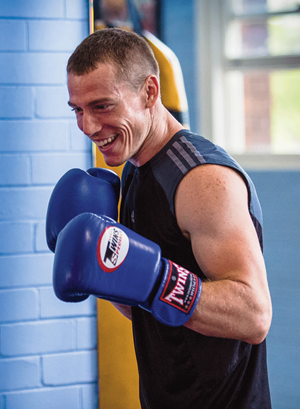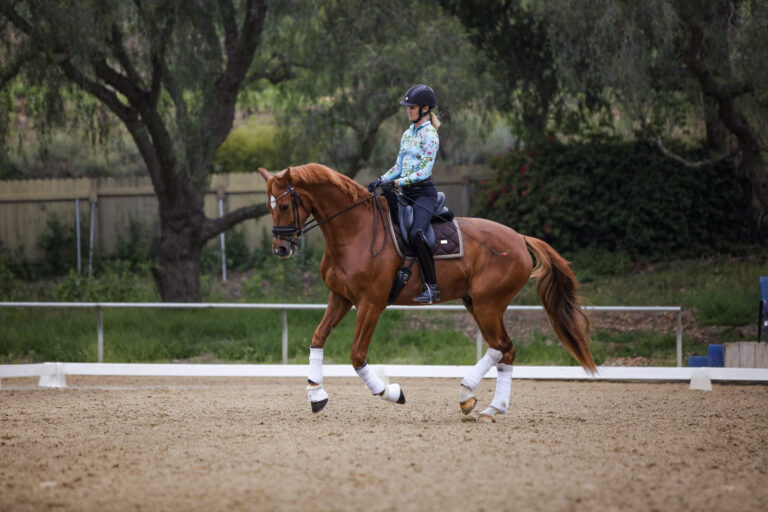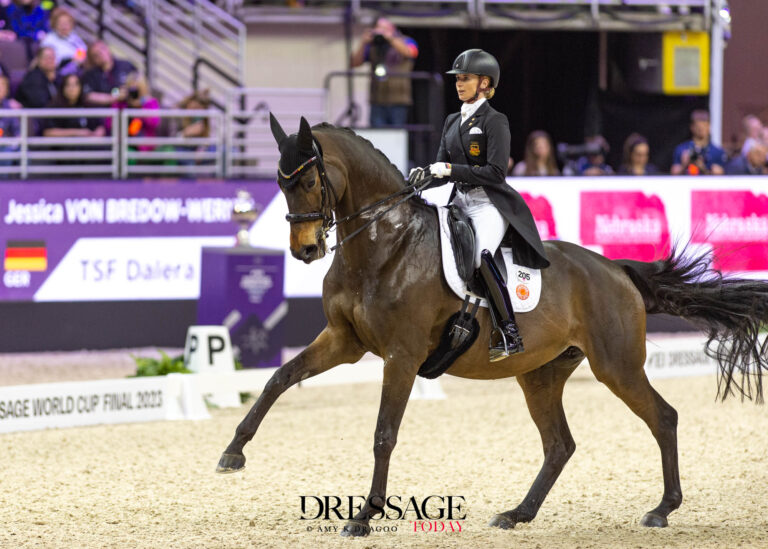The precision of dressage requires that a rider develop effective reactions. There is no point in feeling a certain stimulus from the horse but not be able to react quickly enough. Getting ample time in the saddle will, of course, improve your reactions, but good fitness and body awareness can help you develop the ability to move your body exactly how you want, to the degree you want, as quickly as you want and as accurately as possible.

A well-timed reaction is an important skill to have as a rider. Part of a reaction is the speed at which you respond to a specific stimulus. The quicker we react to a situation, the better prepared we are to handle that situation. For example, if you quickly react to your horse slightly leaning against your inside leg, it is less likely that that slight lean will turn into more severe crookedness. As a dressage rider, you want to correct things before they turn into big issues that the judge can see. Fast reactions can allow you to whisper to your horse with your aids, rather than shout. In dressage, as in other riding, you need to be making constant tiny adjustments: having a quiet conversation with your horse rather than sitting and doing nothing and reacting only when a big problem arises or, alternatively, locking onto your horse with your aids, deadening him.
Knowing your horse well and therefore being able to better anticipate his reaction is beneficial, but we all know horses are their own beings and flight animals that can react quickly to stimuli. We need to be able to keep up. Good reactions also prevent you from becoming unseated if your horse finds himself unbalanced, or if he tries to unbalance you with a big buck.
Your riding ability and confidence levels will also affect reaction and so will levels of pressure. Reaction time decreases as pressure increases. Therefore extra reaction training is important for more novice riders who are still learning the ropes as well as elite athletes under pressure to perform well at the Olympics. A sharp and alert brain will also have an effect so make sure your lifestyle supports this. Good nutrition, healthy sleep habits and positive thought patterns will be of great benefit.
It’s harder to train reaction on the horse. As a dressage rider, if you want to up the ante, you could take your horse out of the arena and onto a racetrack for a gallop or compete in a small eventing class with cross country. But reaction training systems such as overspeed training, which is training yourself to be quicker than needed, are not always conducive to harmony with your horse. That is why it is good to train these methods out of the saddle.
Boxing
Watch a video clip of Mike Tyson or Muhammad Ali boxing and try to tell me the sport isn’t good for training reaction. Those guys are fast! The added bonus of boxing is that it’s great for cardio and improves endurance so you can perform at your peak right to the end of your training session or your test. You have to move fast with control and think quickly while working from the core. I spoke to boxer and personal trainer Trent Simpson about the benefits of riders using boxing as part of their training.
“Boxing is a high-intensity, full-body workout, which challenges both the aerobic and anaerobic metabolism system. Technique requires the individual to use all parts of the body, starting from the ground up, to produce power for the punch,” he says. “This power is transferred through the kinetic link from the leg drive, hip rotation, core activation and, finally, driving the arm from the body to deliver the punch. Boxing is a fun way to burn fat, tone up and get fit.”
Another big benefit of boxing, that is essential to riders, is awareness of what’s going on around you, including the state of your opponent or in the rider’s case, the horse. Simpson continues, “Boxing requires good rhythm, footwork and the ability to recognize your surroundings as when facing an opponent: You are looking to avoid and block punches as well as return punches. It’s a very tactical sport that requires both great mind and body activation, plus it is a great way to reduce stress.”
How often should we use it as a cross- training activity? As boxing is considered to be a high-intensity workout, adequate rest is required. Two to three one-hour sessions could be included in an individual’s training regime when taking into account other training and fitness levels. Training sessions would include skipping, punching on punching bags and focus mitts. This improves an individual’s timing, strength and rhythm.
Juggling

Although it is not as energetic as boxing, juggling is a simple (if not always easy), cheap exercise that also helps to train reaction. You can do it almost anywhere and can do it on your own. Juggling will help your hand/eye coordination and sharpen your brain. It also teaches you to react from a place of relaxation, not tension. It can improve your peripheral vision and teach your body to multi-task with rhythm. This exercise also happens to be a favorite of Dutch dressage champion Adelinde Cornelissen.
Slapping Hands
You can grab a friend and have a laugh with this final exercise. Face your partner with your hands out straight in front of you, with your palms down and your fingers touching the tops of your partner’s hands. Your partner, whose hands are below yours, tries to hit the tops of your hands, while you try to pull yours out of the way before they get hit.
After a few tries, you and your partner can switch positions. You can also attempt this exercise standing on one leg or even on a wobble board if you like to live on the edge!


Rebecca Ashton is a qualified Pilates instructor, a British Horse Society-trained instructor and an Equestrian Australia-accredited dressage coach. She has competed through Intermediaire II, working with riders such as Anky van Grunsven and earning championship titles in the small tour. She lives in Australia and teaches clinics internationally (equestelite.com).











